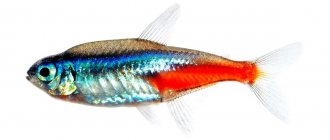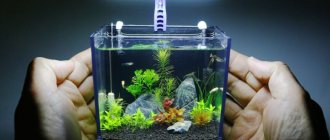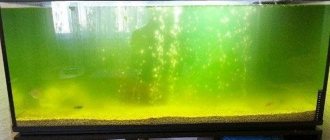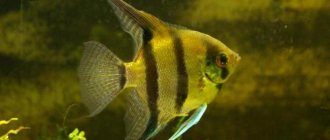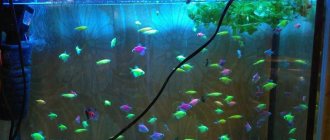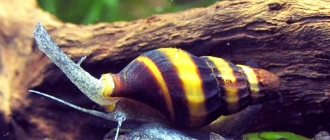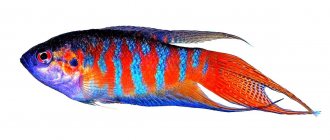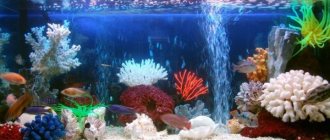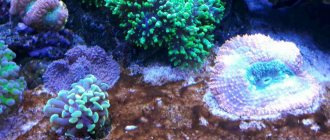Blue Dolphin (Cyrtocara moorii) is a beautiful aquarium fish brought from African countries. This is a cichlid that stands out for its bright and memorable color, as well as the unique shape of its body with a fatty bump on its forehead.
A fish with such a romantic name cannot be ugly. The resemblance to a dolphin is really noticeable (as demonstrated by numerous photos on the Internet). A high convex forehead, thick mobile lips, a lean body and fins directed backwards. This is a blue dolphin - an aquarium fish that changes several shades of blue during its life cycle.
History of the name
Description of a small dolphin. The blue-lipped dolphin cichlid was first introduced from Africa, where it can grow up to 25 cm in length. In a home aquarium, a dolphin can be grown to a maximum size of 20 cm.
It is called a dolphin due to its external similarity with this mammal. At the beginning of their lives, the fry do not closely resemble dolphins, but as they grow older, a pad of adipose tissue forms on the forehead, due to which a great resemblance appears. Under the convex forehead there are large eyes and protruding lips.
Adults are light blue with faint spots. During the mating season, the male's hue becomes bright blue, his forehead turns yellow, and transverse stripes appear on his body.
Caring for fry
Caring for dolphin fry will require a lot of time and effort from the owner of the reservoir. After a little more than two weeks of gestation, the babies hatch, and aquarists feed the fry with brine shrimp, crustaceans, tubifex and other food additives. It should be noted that the offspring are sensitive to the parameters and composition of water and nutrition, and any error will lead to death. The blue dolphin fry grows slowly, adding 8-10 mm per month. When the babies grow to 13-15 cm in length, young pets are seated in containers for adult phenotypes. The fish reach sexual maturity at the age of 1-1.5 years, and retain this ability until 7-8 years. Aquarium fish blue dolphins are cute and entertaining pets whose funny behavior you can watch for hours. Despite the difficulty in breeding the phenotype, the effort is worth it - dolphin fish, if certain conditions are met, will delight the owner for many years.
Distinctive features
Compared to the inhabitants of the underwater world, Malawian cichlids have unique behavior and memorable colors. A prominent representative is the blue dolphin fish, the contents and appearance of which have ensured its popularity among aquarists.
In an adult, there is a clear resemblance to the mammal of the same name.
Introduced to Europe about 50 years ago, these fish never cease to amaze with a character that goes against the grain of other cichlids. They are peaceful, fearful, good-natured and curious. There may be skirmishes between males over territory, but in general, choosing a neighbor for the aquarium is not a problem.
A native of the African Lake Malawi in nature can reach a length of 25 cm. In an aquarium, depending on its volume, the size varies from 8 to 20 cm.
The main characteristics are as follows:
- the head is large, the eyes are mobile, there is a large fatty lump on the forehead;
- the dorsal fin is long (from the head to the base of the tail). The pectoral and ventral fins are short and thin, the tail is symmetrically bilobed;
- the body is flattened laterally, tall and slightly elongated, and has a beautiful blue color. Large dark spots are visible in its center and on the tail, and black stripes on the sides;
- young dolphins are gray-bluish with a metallic sheen. On the sides of the body there are dark transverse stripes.
During conflicts or other processes of excitement, the color of the males becomes brighter, turning blue. The throat and fins practically turn black.
Sexual differences and their reproduction:
The male and female of blue dolphins are practically no different. Both have the same coloring with a fatty bump on the forehead. Relative signs of difference are the size of the body and the cone. In males they are larger. Also, males are slightly brighter than females. Blue dolphins form polygamous unions, consisting of a single male and three to six females. It is not easy to determine the gender of cichlids, so it is very advisable to stock 10 or more fry and raise them together. Mature fry grow from 12 to 15 cm, then they are resettled.
The female does not participate in any way in arranging the place for laying eggs, this is the concern of the male. As a result, he takes a liking to a smooth stone or a hole in sandy soil. Then spawning begins, the male invites the female, there she lays eggs, and the male fertilizes her.
The fish begin their journey from caviar to fry in the female’s mouth. So she wears them for two to three weeks. 20 - 90 eggs are placed in the female's mouth. The incubation time depends on the water temperature. When the fry hatch, they still hide in the female's mouth during the dark period and when danger comes. The first food for fry is Artemia naupilii. The fry grow slowly.
Pecilia balloon care and maintenance
Feeding blue dolphins
Feeding this type of cichlid must be correct - balanced and with a rich diet. This is the basic rule of breeding - it becomes the key to success.
Feeding must be varied with the addition of dry and live food. It is also necessary to take into account the preferences of specific individuals and include in the diet more of their favorite foods containing proteins and plant components.
What to include on the menu?
A balanced diet matters. Despite the fact that any food is adequately perceived, a well-designed menu should contain a lot of protein (for example, tubifex or brine shrimp are suitable).
It should be remembered that in nature they are omnivorous predators that feed on benthos (organisms living on the soil of a reservoir and inside it). Therefore, aquarium dolphins also feast on small fish. However, it is safe to give such food if you are sure of its quality. The presence of pathogenic microorganisms can provoke putrefactive processes in the aquarium.
Frozen and dry food, various types of minced meat and concentrates are acceptable. Plant foods that stimulate digestion and are rich in vitamins are also needed.
When making efforts to organize meals, it is worth recording the amount of food eaten. Looking at the appetite with which the blue beauties eat it, you may not notice overfeeding. And this, in turn, will lead to obesity and organ dystrophy.
Of course, the most popular are dry foods with various functions - to improve color, with vitamins, for feeding fry, etc.
Varieties of cichlids
The cichlid family, despite their ubiquity, is usually divided into three large classes:
- South American - prefer soft water;
- African - love habitats with medium and high rigidity;
- Asian is the smallest class.
They include many species that differ somewhat in shape, size and behavior.
South American cichlids
Of these, the following varieties are especially popular.
Akary
These fish are small to medium sized cichlids. Quite peaceful ones are known among cancers, for example, the bluish-spotted one, and, conversely, even overly hostile species (turquoise).
Spotted Acara is found in the natural environment in calm waters of Panama and Colombia. At the beginning of the 20th century, this fish was brought to Europe and Russia by professional aquarists.
In artificial reservoirs it grows up to 5-7 cm, in nature it is much larger (about 15 cm).
The flattened tall body has a rounded shape, the grayish color of the skin is practically invisible under the greenish-golden scales. There are large dark marks and several vertical stripes on the sides. The gills are covered with an intricate blue pattern. The dorsal fin has a pink border in males, and a white border in females.
These fairly peaceful fish can be safely kept with other species.
Nannakar anomalies
The natural habitat of this species is the small reservoirs of Guiana. Introduced to Europe and Russia in the mid-20th century.
The fish are small - the size of females rarely reaches 3 cm, males are larger - up to 8 cm. Males are painted in turquoise tones with a scattering of dark marks, and a blue pattern is visible on the gills. The fins on the back have a green-blue tint, the belly fins are lemon and green, and the fins on the chest are transparent.
Females are not so bright, yellow in color with dark stripes along the sides. They behave quite calmly in the aquarium, but during the spawning period they become simply uncontrollable, even attacking other cichlids. At this time, they should be placed in a special spawning tank with abundant greenery.
Apistograms
These South American cichlids form a very large species that includes various subspecies. The most popular Apistograms are Ramizer, Kakadu, Two-Stripe, Panda, Hongslo.
Ramizer
They live naturally in the reservoirs of Venezuela. European and Russian aquarists began propagating them in an artificial environment in the 60s of the last century. They belong to the dwarf cichlid breeds; a rare individual reaches a size of 5 cm.
A tall, flat body of a yellowish color with a greenish or purple tint, with the same spots on the sides. There is a bright dark mark on the stomach, and two vertical stripes of the same color on the head between the large eyes. Males are larger than the brighter females, whose abdomen is usually purple-scarlet.
This species is absolutely non-aggressive and can get along with any aquarium inhabitants.
Cockatoo
Sometimes they grow up to 7 cm. They have a bright color, dominated by red, orange and gold tones. The dorsal fin resembles a fancy mottled scallop. These fish are quite angry.
Altispinosa or Bolivian butterflies
The most unpretentious representatives of this species, very bright and colorful, compatible with other fish. One of the few subspecies of cichlids that can be practiced by a novice aquarist.
Two-way or Biteniates
Small (up to 7 cm) and very active fish, beautifully colored with a characteristic dark stripe along the sides. Males are larger and brighter than females. Usually the main background is yellow, and the fins have a blue tint. It lives naturally in the rivers of Peru, Bolivia, and Brazil. Omnivorous and unpretentious in maintenance.
Panda
A very beautiful and small (up to 8 cm) fish that lives in the basin of two rivers in Peru - the Ucayali and Yavari. The color is yellow throughout the body and fins with dark markings, often in the form of vertical stripes near the head and a bluish tint. Carnivorous, but unpretentious in care.
Hongslo
Small, predatory and very bright fish. In nature, they live in the reservoirs of Colombia and Venezuela. Females are about 4 cm, males - 6 cm. They are brighter and more powerful, the color is dominated by reddish-yellow and orange tones. The fins are high-standing, sharp along the edge. In nature, they usually eat bottom invertebrates, but in an aquarium they are omnivorous and quite calm when there is an abundance of food. Monogamous, it is better to keep them as a pair or a small harem.
Cichlazomas
They have elongated slender bodies, sometimes reaching a length of 15-17 cm. There are many subspecies of them - Black-striped, Flamingo, Meeks, Festums, Peaceful, Yellow. All of them are distinguished by the presence of bright stripes or spots on the body.
Black-striped cichlazomas live in small lakes in Guatemala. In Europe and Russia, they began to successfully select this species in the 60s of the 20th century.
The body is rather gray in color with multiple (up to 9) black stripes arranged vertically, often because of this they are called Zebras. Females are slightly smaller than males with a more contrasting pattern and an orange belly. They are quite unpretentious and calm, but prefer large bodies of water with abundant vegetation.
Angelfish
Perhaps this is the most common variety of cichlids; they appeared in European aquariums already in 1909. In nature, they are numerous in the slow and wide rivers of South America.
They have a characteristic large body shape, resembling a crescent, a modified triangular shape, with long and voluminous fins. The native color - white with black stripes - is now rare in aquariums; there are many brightly colored breeds obtained through breeding. They differ in color, various body shapes and fins. Very peaceful and unpretentious inhabitants of reservoirs, they are loved by both beginners and professionals.
Discus
These fish are rightfully considered one of the most expensive and even elite. It is very difficult to maintain them so that you can admire the aquarium for hours. They are capricious both in terms of food and living conditions. In addition, they are very unstable to stress.
Its natural habitat is the calm waters of the Amazon. They appeared in Europe in the 30s of the last century, and the first experience of successful artificial breeding dates back to the 60s.
They have a large, almost round, flattened body (up to 20-25 cm). The color of natural species is bright brown with vertical dark stripes (there are 9 of them) and a greenish tint. Selected species of different colors - red, yellow, pink, white, blue.
These are peaceful fish, but for successful keeping it is better not to add other species to them.
The most famous breeds of discus are Heckel, Pigeon Blood, Leopard, Green, Cobalt, Marlboro, Blue Diamond, Snakeskin, San Mera, Red Melon, Red Card.
Astronotuses
Large cichlid species (up to 25 cm), living in nature most often in the waters of the Amazon. In the aquarium hobby, their widespread use began only in the 50-60s of the last century.
The main tone of the slightly elongated body is usually grayish-gray, but it can also have a yellow tint. The fairly large scales are scattered with golden markings in the form of spots and lines. Selection has made it possible to develop various color variations, but black and white and orange are more common.
Astronotuses are capable of digging up the entire soil, displacing the scenery. You cannot house peaceful fish with them, only similar predators.
Geophagus altifronsa
They have elongated massive bodies up to 20-22 cm. They live in the natural environment mostly in the Rio Negro River basin, they love lowlands and muddy floodplains, but with clean water.
Color ranges from yellow-orange to bluish. Large head with elongated lips. Sexual dimorphism is practically not developed; male and female individuals are very difficult to distinguish.
Peaceful and unpretentious inhabitants, they prefer to live in a flock of 5-8 individuals. Suitable for beginner aquarists.
Cichlids of Africa
This group is also diverse.
Handsome chromis
These small cichlids were introduced to Europe and Russia at the beginning of the 20th century. The maximum body size of aquarium species is 12 cm. The usual color is brown-red, and the spawning period becomes bright scarlet with iridescent greenish spots.
Keep only separately from other fish.
Celmatochromis pulchera
In nature, they live in tropical waters of West Africa. They appeared in European countries in the middle of the last century.
They have a variegated color with a greenish-golden background, a black back and a longitudinal graphite stripe on the sides. The plumage is dotted with dark markings, and on the belly there is a scarlet spot, better expressed in females.
Moderately hostile species, can be kept with fish of similar character.
Labidochromis yellow
Endemic to the African Lake Malawi, its description appeared in 1958.
The main color is bright golden with thin black edging on the fins.
Some varieties can show restrained aggression, but it is best kept only in species aquariums.
Haplochromis venustus
These cichlids are also an endemic species of Lake Malawi.
In captivity they grow to 25 cm or more. They have a golden-olive color with light markings throughout the body. This pattern is more contrasting in females; there are blue dots on the gills and fins.
Very smart hunters, attacking prey from bottom sludge, having previously buried themselves in it. You should not house them with other fish.
Melanochromis auratos
Another representative of Malawian hunters. Auratos have very pronounced sexual dimorphism - males are rather black with a white stripe on the sides, females are light in color with a graphite line along the entire body. Aggressive, kept only in cichlids.
Melanochromus aureus
These South African cichlids are large, beautiful predators. They are painted in golden tones, contrasting with the graphite fins.
Blue dolphins
The body shape of this underwater inhabitant of African lakes really resembles a dolphin. The color is light with a silvery-bluish tint. Peaceful and friendly fish, unpretentious in maintenance.
Red Devil
Cichlazomas labiatum are distinguished by a very exotic appearance and bright coloring, undemanding conditions of detention, and high endurance. But they weren’t called devils for nothing; they are extremely quarrelsome.
They are an endemic species of the tectonic lakes of Nicaragua and Managua, united by the underground Tipitapa River. A very large species, some individuals reach a length of 35 cm. Males are larger than females and have a pronounced occipital growth. The color of the scales ranges from soft lemon to bright orange.
Suitable only for keeping in a species aquarium.
Princess of Burundi
Cyclida Fairy is named after the name of the area where it was first discovered on the coast of the lake.
The most popular fish of Lake Tanganyika. Quite calm, if the size of the artificial reservoir is large, it is able to get along with other fish. It is better to keep 2-3 females with one male.
They are distinguished by their small size (up to 9 cm), weak sexual differences between males and females, gray-yellow colors, high fins with a bluish tint along the edges.
Dimidochromis
A very bright and beautiful predator, whose color is dominated by orange and blue tones. The head is large with powerful jaws.
It is endemic to Lake Malawi. In a large species aquarium it can get along with other large aggressive fish. It is difficult to keep at home, since the size of the smallest individual exceeds 25 cm.
The body is large but flat, it is the most flattened cichlid of Malawi. Males are metallic blue with bright orange fins, females and juveniles are rather simply silver.
Zebra Mbuna
One of the most hostile fish in Lake Malawi. Suitable for keeping in a species aquarium only.
"Mbuna" means "cliff dwellers", which describes the favorite habitats of this species.
A small fish (7-9 cm) has a large convex head and high-standing fins, pointed at the edges. There are a variety of colors - charcoal white, orange, blue-black, but the most common are blue and light blue tones with vertical stripes of the same color, but more saturated.
Queen of Tanganyika
The zebra lobed cyphotilapia or Frontosa is endemic to East Africa's Lake Tanganyika. It usually settles at very great depths (up to 70 m) along the rocky coastline. This is an insidious predator that, in a species aquarium, if there is sufficient food available, behaves quite peacefully.
A strong body up to 25 cm long has a large head with a characteristic growth on the forehead; it is more pronounced in males. Otherwise, sexual dimorphism is not developed. The main background is light, it is crossed out by wide dark stripes, making the fish really look like zebras. The sharp fins are colored in blue and bluish tones.
Asian cichlid species
There are only two naturally occurring species of cichlids thought to be found in the Asian region, but there are several others that overlap with the South American ones, such as the Oscars.
Spotted etroplus
Inhabitants of fresh and brackish waters of Sri Lanka and India.
Small fish, the maximum size of which rarely reaches 9 cm. Sexual dimorphism is weakly expressed, but males are slightly larger and brighter. They are quite peaceful and do not like to dig up the soil. Some aggression is shown during the period of caring for the fry.
The juveniles are very beautiful, the head is large with such large eyes that they seem to occupy its entire area. The main color is deep brown, and the chest is bright orange.
Green etroplus
Also common in water bodies of India and Sri Lanka, where they grow to almost half a meter in length.
In an aquarium, at 10-12 cm they already reach sexual maturity, growing to a maximum of 30 cm. They have a greenish color of scales and fins.
They are quite calm and peaceful, but they eat all aquatic plants.
Oscars
A very popular aquarium fish, which includes many subspecies with different fin shapes and scale colors.
They are found in nature in South and even North America, but an Asian species that lives in the reservoirs of Singapore is also known.
This is a fairly large fish, up to 35 cm long. The dark background color is colored with bright red spots. The high fins are black. This coloring is characteristic of natural species; breeding species are distinguished by a wide variety of colors.
After the Gulf War, many natural species of Asian cichlids were on the verge of extinction, so African tilapia are now introduced into reservoirs.
Multiple aquarium varieties of Asian cichlids have been bred based on natural isomorphs - Israeli Tilapia, Nile, Mango, Redberry, Ironocyclagordonsis, Green Chromide.
Care and maintenance
For proper and comfortable maintenance of the fish, it is better to choose a spacious aquarium - from 300 liters or more. Another necessary condition is maintaining cleanliness and constant constant water parameters. At home, the fish lives in African lakes, where the water is alkaline and has a water temperature of 28 degrees. A dolphin will feel fine in an aquarium if you try to maintain the temperature between 24 and 28 degrees.
If the water is too soft, it will need to be made hard artificially, for example, by pouring coral chips into the ground. Some breeders believe that such water can negatively affect the vision of cichlids, but this fact has not been scientifically confirmed.
Blue dolphin will take root best in a container with coarse sand, densely planted with bushy plants with strong roots. Aquarium dolphins feel great if the following rules are observed:
- bright light;
- increasing water temperature to 30 degrees;
- changing a third of the water in the aquarium every week, provided that it is first passed through biological filters;
- alkaline reaction of water;
- good organization of aeration.
Behavior
Blue dolphins are distinguished by their intelligence. As parents, they take care of their offspring. Their movements are graceful and sedate. The actions of the males, when they want to please the female, are fascinating: they demonstrate their capabilities as excellent swimmers, while their fins are straightened. Fish can recognize their owner.
Blue dolphin in an aquarium:
Who to put in the aquarium with?
The question of the compatibility of such fish in an aquarium is rather of a precautionary nature. The dolphins themselves will not show aggression towards their neighbors (not counting the “trifles” that they will not refuse to feast on). But large relatives - cichlids - can offend with their aggression. Cannot be housed with mbuna or similar species.
Optimal aquarium relationships according to the descriptions are with frontosas, African catfishes, veiled synodontis, aulonocara and others like that. Barbs will also work. A beautiful aquarium, which is home to a blue dolphin and a contrasting labidochromis.
Compatibility with other fish
The blue dolphin is compatible with other cichlids (small, medium and large), frontosas, barbs and catfish. Other Malawian fish would be ideal neighbors for the dolphin, but you should try to avoid placing Cyptokara muri in the same aquarium with mbunas (they are too aggressive - conflicts will occur). Blue dolphins can combine beautifully and peacefully coexist with cichlids of the species Cichlazoma severum (false discus). They also have a calm, peaceful character.
A bright orange cichlid fish harmonizes with a blue dolphin
Reproduction processes
Success in breeding blue dolphins at home depends 90% on their own health. The remaining 10% comes from feeding the fish. It is necessary to include high-quality oligochaetes in the diet.
At the age of three years, the tsirtokara muri reaches sexual maturity. Reproduction occurs in the absence of other fish in the aquarium.
Males ready for spawning behave excitedly and may show unusual aggression, but only towards other males.
The male carefully examines the bottom and selects a place for the female to lay eggs. Often this place is the surface of a smooth stone. If this is not found, he digs a hole in the ground.
After fertilization of the eggs, the female hides them in her mouth. Spawning continues for 1 hour. During this time, the couple manages to lay up to 120 fertilized eggs, from which, in a good situation, up to 60 fry will appear.
After emerging from the eggs, the fry grow slowly. It is recommended to feed them with small cyclops and daphnia. After a few days, crushed tubifex can be included in the diet.
Breeding and caring for this type of cichlid is not at all easy; you will need to put in all your efforts and skills, but the results are worth it. Blue dolphins will delight breeders for many years to come.
Breeding
Blue dolphins are polygamous by nature and form a matriarchal family. For blue dolphin fish, captive breeding is not an easy process. It is recommended to have one male and 3-6 females. To do this, buy 10-15 fry in advance and let them grow together, this is necessary to create a pair. Fish become sexually mature when they reach 12 centimeters in length.
Requirements for the spawning tank
- The spawning tank should be at least 150cm long and set up as above, with the addition of a few large flat rocks to create potential spawning sites.
- Water hardness: 5-20 dGH.
- pH 7.5-9.0
- Water temperature: 25-28oC.
- Provide adequate filtration and aeration system.
Breeding procedure
- The male will select a place for breeding: it will be a stone or other flat surface, and will also dig a hole for the eggs in the substrate.
- Next, the male will show his bright colors to the female until she swims after him to the designated place. There the female will lay eggs and the male will fertilize them.
- The woman will collect the eggs in her mouth for incubation. Care a brood of 20 to 100 fry for one to three weeks.
- The female dolphin is known to "spit out" her brood when she is stressed, so extra care should be taken if you decide to move the fish.
- By the time the female releases her brood, the blue dolphin fry are large enough to eat small shrimp, nauplii, and crushed flake food on their own. The female may continue to mouth the fry for several more weeks at night or when she senses danger.
Description and natural habitat
In Latin, the correct name of the species is cyrtocara muri. The fish lives in Africa, in the lakes of Malawi. They love coastal areas and can dive to depths of 3 to 15 meters. The fish were first described in 1902, but they began to be kept in aquariums only in 1968. The popularity of the dolphin is due to the way it looks - the body has a pronounced blue color, and there is a fatty lump on the front of the head. The body shape resembles that of a bottlenose dolphin. If kept well in captivity, dolphin fish can live up to fifteen years.
Aquarium setup
Due to their high territoriality and not the most accommodating nature, blue cancers are recommended to be kept in species aquariums. This makes it much easier for novice aquarists not only to maintain peaceful coexistence, but also to create ideal conditions.
It is recommended for 1 pair an aquarium with a bottom size of 120x30 cm and a volume of at least 70 liters. It is recommended to fill the bottom of the container with coarse sand, since fish like to arrange it in their own way - moving stones, digging ditches and holes, uprooting plants. Sand will prevent turbidity and allow the water to remain clean.
To construct shelters, specially prepared branches and driftwood are placed on the bottom. Grottoes with a wide entrance are made from large stones. You can use ready-made aquarium forms or build tunnels from scraps of plastic pipes.
The main condition is the strong fastening of decorative elements and fragments of shelters. A strong blue acara can break glass or break internal equipment, causing harm to the inhabitants of the aquarium and itself, arranging the territory to its liking.
Green plants will not only provide desirable cover for adult fish and growing fry, but will also provide an attractive backdrop for beautiful blue cancers. For landscaping, you need to select plants with a strong root system, strong stems and wide, dense leaves. It is also important to take into account the characteristics of the water.
Species that grow well in slightly alkaline and slightly acidic water can be placed along the back wall of a home pond, used to zone an aquarium, or arranged in separate groups:
- nymphea;
- ferns;
- gymnocoronis;
- giant vallisneria;
- hygrophila;
- cryptocoryne;
- Echinodorus;
- aponogeton ulvoides.
Cichlids are indifferent to floating plants. Therefore, you can create twilight and enrich the water with oxygen using:
- duckweed;
- salvinia floating;
- pistia;
- riccia;
- Azolla carolina.
Anubias nana bushes will look beautiful on driftwood. Plants not only need to be strong and tough to withstand the attacks of Blue Acara, but they also need to recover quickly.
Some aquarists advise replacing live plants in cichlids with dummies or doing without them altogether. But blue cancer has a fast metabolism and a good appetite, which causes water pollution with organic waste.
In order to remove nitrates, phosphates and other waste products of aquarium inhabitants, not only powerful filter systems are needed, but also a combination of them. Plants will also provide biological purification of water.
To recreate a natural biocenosis, it is necessary to maintain certain temperature and chemical parameters. For adult cancer, the following are favorable:
- temperature – 22-28°C;
- – 6,5-8,0;
- hardness – 90-447°.
For good health, fish also need filtration, aeration and weekly changes of up to 1/3 of the water volume.
It is better to place filters, heater and other service equipment outside to provide as much space as possible for the cancer.
Diseases and prevention
The blue dolphin does not suffer from atypical diseases, so most often the reason for the ill health of an aquarium fish is a simple failure to comply with living conditions. The reason is insufficient filtration of water, which contributes to its stagnation and the proliferation of pathogenic microorganisms. If there is insufficient aeration, the individual suffers from oxygen deficiency and may die. The volume of the aquarium is also important, because in an aquarium that is too small, substances toxic to fish - nitrates, nitrites and ammonia - appear in high concentrations. This provokes a decline in immunity, so these parameters must be monitored very strictly.
Diseases are possible not only from improper aquarium conditions, but also from stress. In this case, it is enough to create the proper conditions and the problem will go away on its own.
Mr. Tail Recommends: Cichlid Aquarium Basics
Even if only cichlids are stocked in the aquarium, it is very interesting to observe their behavior. These fish amaze not only with the beauty of their coloring, but also with their active social life, high intelligence and touching care for their offspring.
The most common cichlids kept in home aquariums are angelfish, discus, melanochromus, oscar, chromis, and cichlas. Among these species there are individuals that differ significantly in size, shape of the body and fins, and type of nutrition - these are omnivores and predators.
But the general requirements for keeping cichlids are the same:
- They need spacious tanks with a capacity of at least 60 liters, and preferably 300-400 liters.
- It is necessary to provide for the organization of grottoes, caves, driftwood, which will have not only a decorative, but also a protective function.
- It is better to house cichlids in pairs or small families, where there are 2-3 females per male.
- Optimum temperature +27…+28 °C.
- Regular changes of a third of the water should be done at least 2 times a week.
- It is mandatory to install powerful, preferably remote, filters and an aeration system.
- It is better to install a special lid with an artificial lighting system on the tank.
Experienced aquarists believe that the best cichlid is a bare stone wasteland, and it is better to install artificial plants, since live ones will be eaten instantly.
But for some species of cichlids, such as apistogramma and parakeets, you can organize a real underwater garden. Only in this case is it important to correctly zone the reservoir, creating areas of grottoes and thickets there, as well as free space for the active movement of individuals.
Zoning is very important for group keeping, for example, angelfish, since each pair occupies its own territory, which it actively protects.
Vallisneria, which, when growing, creates a kind of screen-thickets, is well suited as a plant for these species of cichlids.
For Malawian cichlid species, it is a good idea to float duckweed on the surface of the water as natural feeding. Decorative grottoes, coconut halves, driftwood, pots and amphorae also help with zoning. The soil is not so important; cichlids are indifferent to it. Lighting in an artificial tank should be moderate, in cool colors.
